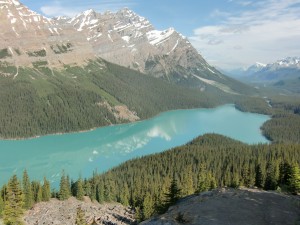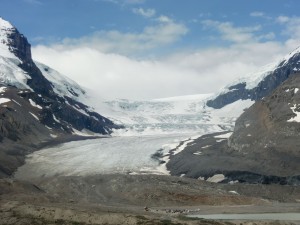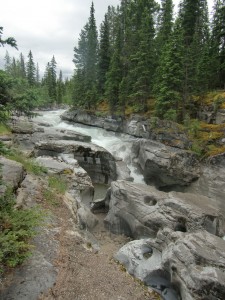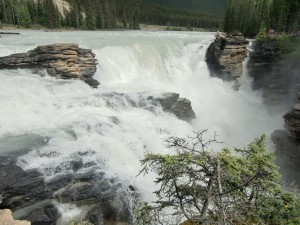EXPLORING THE ROCKIES – JASPER AND THE ICE FIELDS
EXPLORING THE ROCKIES
This is the fourth in a series of articles about traveling in the Canadian Rockies
JASPER AND THE ICE FIELDS
By Charles N. Stevens
Photos by Dolores Seidman
We wake up to a glorious morning of sunshine and clear skies in Banff, the towering “rock” that we see from our window bathed in sun. We snack on banana bread and chamomile tea for breakfast in our room as we look out on our special mountain.
After breakfast, Dolores and I take a walk along the nearby Bow River, the one that flows through Banff. The water is flowing so smoothly that it mirrors the trees along its banks. The river had overflowed recently, leaving scars and gray mud along its edges that we have to avoid.
Our bus rolls out at eight and soon we are on our way to Jasper. Leaving the civilization of Banff, we are out once again into the breathtaking scenery of the Canadian Rockies, traveling along the Bow River with dense forests and snow-dappled peaks all around. We enter a great saddle valley carved out thousands of years ago by a glacier. Far away, we spot a moose grazing in a bog. Turning from that it is amazing to me how thick the lodgepole pine forests are, all those slim gray trunks so close together, almost like a high solid fence.
As we enter Jasper National Park, we leave Highway 1. A sign reads, “You are in Avalanche Country.” We are surrounded by scarred peaks as we travel through the glacial valley. The shapes of the rocks spark our imaginations. One looks like a house with windows and snow on the roof, another like the domes of a temple.
We move on to beautiful Bow Lake and the Bow Glacier that feeds it, a spectacular waterfall cascading down from it. Many of the weathered peaks we see now are above the timberline, bare and exposed to the raw elements of high altitude—rugged nature, cold and hard. Next, we see one of the prettiest lakes found anywhere, Peyto Lake. We see it from above, like a brilliant turquoise setting one might find on Indian jewelry. It is so striking that it hardly seems real. Snowy peaks are mirrored in it and from these peaks issue long ribbons of waterfalls. Snowy peaks seem to go for ever.
In late morning clouds begin to obscure the mountains and soon rain begins to pelt the bus. With the sun gone the sky is now gray and misty, but we can still see waterfalls flowing in long crooked streams. Higher now, we look far down where a river flows, the clouds dimming the colors that we were used to seeing before.
We then approach one of the great sights of the Rockies, the Columbia Ice Field. It sits in a U-shaped glacial valley, only a remnant of what it once was, but still formidable. I saw this ice field in 1970 and was stunned by how much it had retreated since then. I remember how I and my two sons camped across from it for the night many years ago and nearly froze. We still talk about that frigid night and get the shivers. Specially equipped vehicles take people out on the ice where they can look down into deep blue crevasses and walk precariously on the ice. Directly across the street is a lodge for visitors and tourists.
On our way again, we come upon a sign that reads “Caribou Crossing”, but no caribou were crossing at the time. After brief moments of sun, the sky again becomes overcast, the mountains on all sides now veiled in clouds and mist. Light rain begins again. We pass many turnoffs leading to lakes and campgrounds and can’t imagine a better place to camp. We cross over the Athabasca River with its gray-green water where some spot caribou, but alas, I didn’t see any. A sign by the side of the road reads, “Bear Warning. Stay in cars.” Farther on, I see a woman with her umbrella raised sitting at a picnic table, undaunted by the weather.
We stop at Maligne Canyon where a rushing river tumbles through solid stone that it had carved through thousands of years ago. The water thunders as it plunges through, twisting, turning falling and shooting upward. We were taken by the incredible power of it, the way it had smoothed the stone to a near-polish.
After briefly visiting the tourist town of Jasper, their sidewalks crowded with visitors, baskets of flowers hanging from every light standard, we take a side road to Pyramid and Patricia Lakes. At Patricia Lake we walk on a short causeway to Pyramid Island, the weather now gray, windy and cold. To our surprise, a wedding was about to take place on the small island, the women arriving in high heels and flimsy dresses. We are bundled up against the cold and feel sorry for the guests who must be freezing. It was, however, a nice spot for a wedding with its views out over the lake and the mountains beyond.
Back on Highway 93, the Ice Fields Parkway, we spot a few elk and colorful fields of red Indian paintbrush. With clouds wrapping around the peaks, we stop at Athabasca Falls where the river funnels its gray water roaring into a narrow gorge.
As we turn southward, back toward Banff, the weather deteriorates even further. Rain showers dim the mountains that were so clear and sharp on our way up. Then the rain begins in earnest, obliterating our views of the mountains and pounding on the bus. We are wrapped in a gray nothingness of rain. Lightning strikes the ridges frequently, lighting up the mist with its quick blue glow. By the time we reach Banff the sun is out again, but we can hear the rumbling of thunder in the north.
Glad to be back, we snack in our room while gazing out at our sun-lit “rock” and a great colorful rainbow arcing across the east.

Lake Peyto is so unusually beautiful that it hardly seems real.

Even though the glacial Columbia Ice Fields are spectacular, they have retreated significantly in recent years.

The rushing waters of Maligne Canyon have carved a niche out of solid rock.

The roar of Athabasca Falls is a wonder to behold.
MONTEREY PARK AUTHOR PUBLISHES 4th BOOK – Seeking More of the Sky: Growing Up in the 1930’s:
Charles “Norm” Stevens, a 43 year resident of Monterey Park has recently published his 4th book: Seeking More of the Sky: Growing Up in the 1930’s. This is the story of a young boy growing up in Inglewood, California in the l930’s. This was a time during the depression when unemployment was affecting many and the banks were closed, while the clouds of war were gathering in Europe. But he was lucky enough to be raised in a loving family, the power of that love reflected throughout his stories.
Stevens is the author of three previous books about his experiences during WWII:
An Innocent at Polebrook: A Memoir of an 8th Air Force Bombardier (Story of his 34 bombing missions from his base at Polebrook, England over Germany and France)
The Innocent Cadet: Becoming A World War II Bombardier (A prequel to the first, telling of his training in the U.S. before going overseas into combat.)
Back from Combat: A WWII Bombardier Faces His Military Future from Combat: (This book details the time from when he returned from combat in England until the end of the war.)
He is known to the readers of The Citizen’s Voice as the author of Travel Log Articles including “Cruising the Rhine and Mosel”,” Best of the West”, “In Search of Snow” , “From Paris to Normandy on the Seine”, and “Exploring New York”. He is retired, having taught for 32 years, primarily in the Montebello Unified School District.
Those interested in purchasing an autographed copy of any of his books, may contact the author at 323-721-8230 or Normstevens24@gmail.com.



